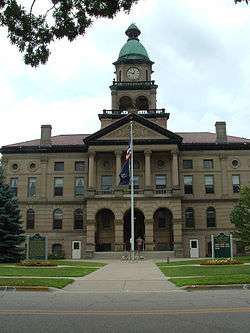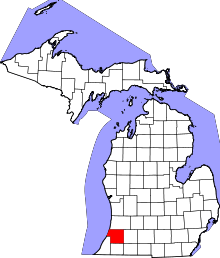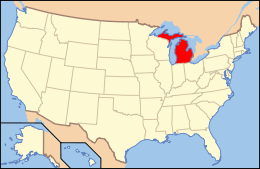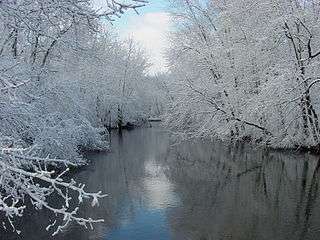Van Buren County, Michigan
| Van Buren County, Michigan | ||
|---|---|---|
 Van Buren County Courthouse | ||
| ||
 Location in the U.S. state of Michigan | ||
 Michigan's location in the U.S. | ||
| Founded |
1829 (created) 1837 (organized)[1] | |
| Named for | Martin Van Buren | |
| Seat | Paw Paw | |
| Largest city | South Haven | |
| Area | ||
| • Total | 1,090 sq mi (2,823 km2) | |
| • Land | 607 sq mi (1,572 km2) | |
| • Water | 482 sq mi (1,248 km2), 44% | |
| Population | ||
| • (2010) | 76,258 | |
| • Density | 126/sq mi (49/km²) | |
| Congressional district | 6th | |
| Time zone | Eastern: UTC-5/-4 | |
| Website |
www | |
Van Buren County is a county located in the U.S. state of Michigan. As of the 2010 census, the population was 76,258.[2] The county seat is Paw Paw.[3] The county was founded in 1829 and organized in 1837.[1]
Van Buren County is included in the Kalamazoo-Portage, MI Metropolitan Statistical Area.
History
The county was named for Martin Van Buren before he became president. He was U.S. Secretary of State and later Vice President under President Andrew Jackson, and thus Van Buren is one of Michigan's "Cabinet counties".[1]
The Van Buren County Courthouse was built by Claire Allen, a prominent southern Michigan architect; its cornerstone was laid on September 2, 1901, after a vote to issue $35,000 in county bonds passed 1,355 to 1,097 on July 29, 1901.[4]
Government
The county government operates the jail, maintains rural roads, operates the major local courts, keeps files of deeds and mortgages, maintains vital records, administers public health regulations and participates with the state in the provision of welfare and other social services. The county board of commissioners controls the budget but has only limited authority to make laws or ordinances. In Michigan, most local government functions — police and fire, building and zoning, tax assessment, street maintenance, etc. — are the responsibility of individual cities and townships.
Elected officials
- Prosecuting Attorney: Michael Bedford
- Sheriff: Dale R. Gribler
- County Clerk: Tina Leary
- County Treasurer: Karen Makay
- Register of Deeds: Paul W. DeYoung
- Drain Commissioner: Joe Parman
- County Surveyor: Donald Gilchrist
- County Commissioners by District Number:
- John Mike Henry
- Susan Hammond
- Richard Godfrey, Chairperson
- Richard W. Freestone
- Mike Toth
- Donald A. Hanson
- Beth Griffin, Vice-Chairperson
(information correct in September 2016)
Geography
According to the U.S. Census Bureau, the county has a total area of 1,090 square miles (2,800 km2), of which 607 square miles (1,570 km2) is land and 482 square miles (1,250 km2) (44%) is water.[5]
Much of the county is farmland dotted with small towns. Areas near Kalamazoo County are becoming suburbanized. Many of the inland lakes are ringed with homes, either by people living year-round or cottagers, generally people who live the rest of the time in Chicago. Tourism is a major industry in the areas near Lake Michigan.
Rivers
Adjacent counties
- Allegan County - north
- Kalamazoo County - east
- St. Joseph County - southeast
- Cass County - south
- Berrien County - southwest
- Lake County, Illinois - west
Parks, preserves, natural areas

- Dunes Parkway, an 84-acre (340,000 m²) preserve of dunes in Covert Township
- Hamilton Township Coastal Plain Marsh Nature Sanctuary, a 79-acre (320,000 m²) preserve of coastal plain marsh in Hamilton Township owned by the Michigan Nature Association
- Jeptha Lake Fen Preserve, a 49-acre (200,000 m²) preserve in Columbia Township
- Kal-Haven Trail, a multi-use trail converted from old rail line that runs from Kalamazoo to South Haven
- Keeler State Game Area, 400 acres (162 ha) (1.6 km²) in Keeler Township
- Northpoint land - high dunes on 17 acres (69,000 m2) on Lake Michigan, north of Van Buren State Park
- Ross Preserve, a 1,449 acre (5.9 km²) preserve of coastal plain marsh in Covert Township owned by The Nature Conservancy
- Van Buren State Park
- Van Buren Trail State Park is adjacent to Kal-Haven Trail
Transportation
Highways
Public transportation
Demographics
| Historical population | |||
|---|---|---|---|
| Census | Pop. | %± | |
| 1830 | 5 | — | |
| 1840 | 1,910 | 38,100.0% | |
| 1850 | 5,800 | 203.7% | |
| 1860 | 15,224 | 162.5% | |
| 1870 | 28,829 | 89.4% | |
| 1880 | 30,807 | 6.9% | |
| 1890 | 30,541 | −0.9% | |
| 1900 | 33,274 | 8.9% | |
| 1910 | 33,185 | −0.3% | |
| 1920 | 30,715 | −7.4% | |
| 1930 | 32,637 | 6.3% | |
| 1940 | 35,111 | 7.6% | |
| 1950 | 39,184 | 11.6% | |
| 1960 | 48,395 | 23.5% | |
| 1970 | 56,173 | 16.1% | |
| 1980 | 66,814 | 18.9% | |
| 1990 | 70,060 | 4.9% | |
| 2000 | 76,263 | 8.9% | |
| 2010 | 76,258 | 0.0% | |
| Est. 2015 | 75,077 | [6] | −1.5% |
| U.S. Decennial Census[7] 1790-1960[8] 1900-1990[9] 1990-2000[10] 2010-2013[2] | |||
The 2010 United States Census[11] indicates Van Buren County had a 2010 population of 76,258. This is a decrease of -5 people from the 2000 United States Census. Overall, the county had a 0.0% growth rate during this ten-year period. In 2010 there were 28,928 households and 20,434 families in the county. The population density was 125.5 per square mile (48.5 square kilometers). There were 36,785 housing units at an average density of 60.6 per square mile (23.4 square kilometers). The racial and ethnic makeup of the county was 82.7% White, 3.9% Black or African American, 0.7% Native American, 0.4% Asian, 10.2% Hispanic or Latino, 0.1% from other races, and 2.0% from two or more races.
There were 28,928 households out of which 33.4% had children under the age of 18 living with them, 53.0% were husband and wife families, 12.1% had a female householder with no husband present, 29.4% were non-families, and 24.0% were made up of individuals. The average household size was 2.61 and the average family size was 3.07.
In the county the population was spread out with 25.5% under age of 18, 7.8% from 18 to 24, 23.7% from 25 to 44, 29.3% from 45 to 64, and 13.8% who were 65 years of age or older. The median age was 40 years. For every 100 females there were 98.3 males. For every 100 females age 18 and over, there were 96 males.
The 2010 American Community Survey 1-year estimate[11] indicates the median income for a household in the county was $44,242 and the median income for a family was $53,642. Males had a median income of $28,079 versus $18,124 for females. The per capita income for the county was $21,495. About 10.0% of families and 14.8% of the population were below the poverty line, including 21.1% of those under the age 18 and 11.8% of those age 65 or over.
Communities

Cities
Villages
- Bloomingdale
- Breedsville
- Decatur
- Lawrence
- Lawton
- Mattawan
- Paw Paw (county seat)
- Grand Junction
Townships
- Almena Township
- Antwerp Township
- Arlington Township
- Bangor Township
- Bloomingdale Township
- Columbia Township
- Covert Township
- Decatur Township
- Geneva Township
- Hamilton Township
- Hartford Township
- Keeler Township
- Lawrence Township
- Paw Paw Township
- Pine Grove Township
- Porter Township
- South Haven Charter Township
- Waverly Township
See also
- List of Michigan State Historic Sites in Van Buren County, Michigan
- National Register of Historic Places listings in Van Buren County, Michigan
References
- 1 2 3 "Bibliography on Van Buren County". Clarke Historical Library, Central Michigan University. Retrieved January 29, 2013.
- 1 2 "State & County QuickFacts". United States Census Bureau. Retrieved August 29, 2013.
- ↑ "Find a County". National Association of Counties. Retrieved 2011-06-07.
- ↑ O.W. Rowland, A History of Van Buren County, Michigan: A Narrative Account of Its Historical Progress, Its People, and Its Principal Interests. Chicago: Lewis Publishing Company, 1912.
- ↑ "2010 Census Gazetteer Files". United States Census Bureau. August 22, 2012. Retrieved September 28, 2014.
- ↑ "County Totals Dataset: Population, Population Change and Estimated Components of Population Change: April 1, 2010 to July 1, 2015". Retrieved July 2, 2016.
- ↑ "U.S. Decennial Census". United States Census Bureau. Retrieved September 28, 2014.
- ↑ "Historical Census Browser". University of Virginia Library. Retrieved September 28, 2014.
- ↑ "Population of Counties by Decennial Census: 1900 to 1990". United States Census Bureau. Retrieved September 28, 2014.
- ↑ "Census 2000 PHC-T-4. Ranking Tables for Counties: 1990 and 2000" (PDF). United States Census Bureau. Retrieved September 28, 2014.
- 1 2 "American Factfinder". United States Census Bureau. Retrieved March 11, 2012.
External links
- Van Buren County - Official Site
- "Bibliography on Van Buren County". Clarke Historical Library, Central Michigan University. Retrieved January 29, 2013.
 |
Kenosha County, Wisconsin | Allegan County |  | |
| Lake County, Illinois | |
Kalamazoo County | ||
| ||||
| | ||||
| Berrien County | Cass County | St. Joseph County |
Coordinates: 42°16′N 86°19′W / 42.27°N 86.31°W
.png)